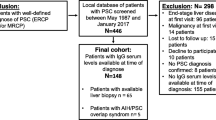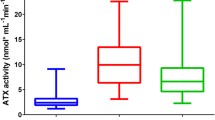Abstract
Background and Aim
Hepatocyte apoptosis or necrosis from accumulation of bile salts may play an important role in the disease progression of primary sclerosing cholangitis (PSC). The aim of the current study was to measure serum markers of hepatocyte apoptosis (cytokeratin-18 fragments—K18) and necrosis (high-mobility group protein B1—HMGB1) in adults with PSC and examine the relationship with disease severity.
Methods
We measured serum levels of K18 and HMGB1 in well-phenotyped PSC (N = 37) and 39 control subjects (N = 39). Severity of PSC was assessed biochemically, histologically, and PSC Mayo risk score. Quantification of hepatocyte apoptosis was performed using TUNEL assay.
Results
The mean age of the study cohort was 49.7 ± 13.3 years and comprised of 67 % men and 93 % Caucasian. Serum K18 levels were significantly higher in the PSC patients compared to control (217.4 ± 78.1 vs. 157.0 ± 58.2 U/L, p = 0.001). However, HMGB1 levels were not different between the two groups (5.38 ± 2.99 vs. 6.28 ± 2.85 ng/mL, p = 0.15). Within the PSC group, K18 levels significantly correlated with AST (r = 0.5, p = 0.002), alkaline phosphatase (r = 0.5, p = 0.001), total bilirubin (r = 0.61, p ≤ 0.001), and albumin (r = −0.4, p = 0.02). Serum K18 levels also correlated with the level of apoptosis present on the liver biopsy (r = 0.8, p ≤ 0.001) and Mayo risk score (r = 0.4, p = 0.015).
Conclusion
Serum K18 but not HMGB1 levels were increased in PSC and associated with severity of underlying liver disease and the degree of hepatocyte apoptosis.


Similar content being viewed by others
Abbreviations
- ALT:
-
Alanine aminotransferase
- Alk P:
-
Alkaline phosphatase
- AST:
-
Aspartate aminotransferase
- HMGB1:
-
High-mobility group protein B1
- K18:
-
Cytokeratin-18 fragment
- PSC:
-
Primary sclerosing cholangitis
- TUNEL:
-
Terminal deoxynucleotidyl transferase dUTP nick end labeling
References
Lee YM, Kaplan MM. Primary sclerosing cholangitis. N Engl J Med. 1995;332:924–933.
Silveira MG, Lindor KD. Clinical features and management of primary sclerosing cholangitis. World J Gastroenterol. 2008;14:3338–3349.
Chen J, Wei Y, He J, et al. Natural killer T cells play a necessary role in modulating of immune-mediated liver injury by gut microbiota. Sci Rep. 2014;4:7259.
Kumar V. NKT-cell subsets: promoters and protectors in inflammatory liver disease. J Hepatol. 2013;59:618–620.
Higuchi H, Gores GJ. Bile acid regulation of hepatic physiology: IV. Bile acids and death receptors. Am J Physiol Gastrointest Liver Physiol. 2003;284:G734–G738.
Fickert P, Fuchsbichler A, Wagner M, et al. Regurgitation of bile acids from leaky bile ducts causes sclerosing cholangitis in Mdr2 (Abcb4) knockout mice. Gastroenterology. 2004;127:261–274.
Tinmouth J, Lee M, Wanless IR, et al. Apoptosis of biliary epithelial cells in primary biliary cirrhosis and primary sclerosing cholangitis. Liver. 2002;22:228–234.
Kawata K, Kobayashi Y, Gershwin ME, Bowlus CL. The immunophysiology and apoptosis of biliary epithelial cells: primary biliary cirrhosis and primary sclerosing cholangitis. Clin Rev Allergy Immunol. 2012;43:230–241.
Denk G, Omary AJ, Reiter FP, et al. Soluble intracellular adhesion molecule, M30 and M65 as serum markers of disease activity and prognosis in cholestatic liver diseases. Hepatol Res. 2014;44:1286–1298.
Tao GZ, Li DH, Zhou Q, et al. Monitoring of epithelial cell caspase activation via detection of durable keratin fragment formation. J Pathol. 2008;215:164–174.
Moll R, Divo M, Langbein L. The human keratins: biology and pathology. Histochem Cell Biol. 2008;129:705–733.
Ku NO, Liao J, Omary MB. Apoptosis generates stable fragments of human type I keratins. J Biol Chem. 1997;272:33197–33203.
Feldstein AE, Wieckowska A, Lopez AR, et al. Cytokeratin-18 fragment levels as noninvasive biomarkers for nonalcoholic steatohepatitis: a multicenter validation study. Hepatology. 2009;50:1072–1078.
Yilmaz Y, Dolar E, Ulukaya E, et al. (2009) Elevated serum levels of caspase-cleaved cytokeratin 18 (CK18-Asp396) in patients with nonalcoholic steatohepatitis and chronic hepatitis C. Med Sci Monit. 15:CR189–193.
Proskuryakov SY, Konoplyannikov AG, Gabai VL. Necrosis: a specific form of programmed cell death? Exp Cell Res. 2003;283:1–16.
Merenmies J, Pihlaskari R, Laitinen J, Wartiovaara J, Rauvala H. 30-kDa heparin-binding protein of brain (amphoterin) involved in neurite outgrowth. Amino acid sequence and localization in the filopodia of the advancing plasma membrane. J Biol Chem. 1991;266:16722–16729.
Bianchi ME, Agresti A. HMG proteins: dynamic players in gene regulation and differentiation. Curr Opin Genet Dev. 2005;15:496–506.
Craig DG, Lee P, Pryde EA, et al. Circulating apoptotic and necrotic cell death markers in patients with acute liver injury. Liver Int. 2011;31:1127–1136.
Wang X, Sun R, Wei H, Tian Z. High-mobility group box 1 (HMGB1)-Toll-like receptor (TLR)4-interleukin (IL)-23-IL-17A axis in drug-induced damage-associated lethal hepatitis: interaction of gammadelta T cells with macrophages. Hepatology. 2013;57:373–384.
Scaffidi P, Misteli T, Bianchi ME. Release of chromatin protein HMGB1 by necrotic cells triggers inflammation. Nature. 2002;418:191–195.
Gardella S, Andrei C, Ferrera D, et al. The nuclear protein HMGB1 is secreted by monocytes via a non-classical, vesicle-mediated secretory pathway. EMBO Rep. 2002;3:995–1001.
Wang H, Bloom O, Zhang M, et al. HMG-1 as a late mediator of endotoxin lethality in mice. Science. 1999;285:248–251.
Kim WR, Therneau TM, Wiesner RH, et al. A revised natural history model for primary sclerosing cholangitis. Mayo Clin Proc. 2000;75:688–694.
Vuppalanchi R, Jain AK, Deppe R, et al. Relationship between changes in serum levels of keratin 18 and changes in liver histology in children and adults with nonalcoholic fatty liver disease. Clin Gastroenterol Hepatol. 2014;12:2121-30.e1–2.
Acknowledgments
This work was in part supported by NIH K24 DK069290A (NC).
Conflict of interest
The authors declare that they have no conflict of interest.
Author information
Authors and Affiliations
Corresponding author
Rights and permissions
About this article
Cite this article
Masuoka, H.C., Vuppalanchi, R., Deppe, R. et al. Individuals with Primary Sclerosing Cholangitis Have Elevated Levels of Biomarkers for Apoptosis but Not Necrosis. Dig Dis Sci 60, 3642–3646 (2015). https://doi.org/10.1007/s10620-015-3805-7
Received:
Accepted:
Published:
Issue Date:
DOI: https://doi.org/10.1007/s10620-015-3805-7




